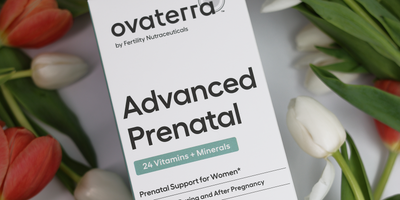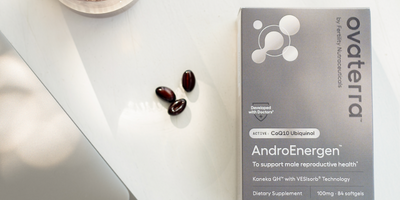PFAS and reproductive health may be on top your mind, as earlier this week, the Environmental Protection Agency (EPA) lowered the health risk threshold for two compounds that belong to PFAS to almost zero. EPA warned that almost any amount, even at levels that current technology cannot detect, is unsafe. What are PFAS? And should you be concerned about PFAS’ impact on your reproductive health? How can you reduce your PFAS exposure? Here’s our quick guide on PFAS and your reproductive health.
What are PFAS?
The two chemicals, PFOA and PFOS, belong to a large group of manmade chemicals called per- and polyfluoroalkyl substances, PFAS for short. PFAS are often called “forever chemicals,” because these long-chain compounds do not break down easily and remain in the environment for a long time.
In the face of mounting evidence that PFAS pose serious health risks, manufacturers in the US phased out some types of PFAS, including PFOS and PFOA, replacing them with newer generation of PFAS between 2006 and 2015. Blood levels of PFOS and PFOA have generally declined significantly since then. However, these retired PFAS chemicals still remain in the environment – and scientists warn that the newer-generation PFAS that replaced PFOS and PFOA may be just as harmful, significantly raising risks of certain cancers and acting as endocrine disruptors.
A wide variety of products contain PFAS
PFAS were first invented in the 1940s, and have been used in a wide range of products since the 1950s. Probably the most infamous of chemical in the PFAS family is Teflon, but there are many others. Products made with PFAS include nonstick pots and pans, food packaging, cardboard boxes, cosmetics, stain-resistant fabric (like carpets) and outdoor clothing with durable water resistance. PFAS is also used in foam used to fight fires.
Where are PFAS found?
Because they take a long time to break down, PFAS are ubiquitous. A vast majority – over 95% – of people who live in the US, including newborn babies, have PFAS circulating in the blood, according to the Centers for Disease Control and Prevention (CDC).
Scientists have found PFAS contamination in over 2,800 locations in the US. (Here’s an interactive map, put together by the Environmental Working Group). A major route of PFAS exposure is our drinking water. There are two other important risk factors:
- Military bases: If you live in or near a current or a former military base, you may be at risk, because military bases use a specific type of firefighting foam that contains PFAS, which seeps into the local ground water.
- PFAS manufacturing: If you work with PFAS or live near a manufacturing plant, your exposure and blood levels are likely much higher. For example, workers at 3M and Dupont, major manufacturers of PFAS, had over 100 times the amount of PFOA circulating in the blood than the general population.
What we know about PFAS and reproductive health
PFAS exposure has been tied to multiple negative effects on reproductive health, both on male and female sides. There may be multiple pathways PFAS affect reproductive processes, but one likely culprit is PFAS' function in the body as a pseudo-hormone (i.e., endocrine disruptor) that interferes with the normal functioning of the natural hormones.
Studies have connected PFAS to:
- Lower testosterone in men
- Lower sperm quality, potentially through PFAS’ effects on the various cells involved in the production and development of sperm cells
- Lower fertility in women: Epidemiological studies have found an association between lower PFAS exposure and higher number of children women have.
- Menstrual irregularities, earlier menopause and hormonal imbalance in women
While scientists are still investigating the mechanisms behind these negative reproductive health effects, some animal and laboratory studies have suggested possible explanations. For example, laboratory studies have shown that PFAS can disrupt the communication between the developing eggs and the support structure that surround the eggs (called granulosa cells), thus impairing egg development and diminishing ovarian reserve.
What we know about PFAS and baby’s development
1. PFAS negatively impacts prenatal outcomes
Scientists are concerned that PFAS may negatively impact prenatal outcomes – i.e., affect pregnancies and baby’s health negatively. For example, in a recent study published in the journal Environmental Health, scientists showed a probable cause-effect relationship between exposure to high levels of PFAS in drinking water and poor reproductive outcomes, particularly the high rate of prematurity and low birth weight.
Comparing two groups in Minneapolis-St. Paul metropolitan area, the analysis found that women exposed to higher level of PFAS were more likely to have preterm births, as well as low birth weight babies. Both of these conditions have implications on the prenatal outcomes, as well as a potential to impact the baby’s life-long health. People exposed to high PFAS levels also had 27% lower fertility rate.
2. Preventive measures can reverse the PFAS’ effects
This study is interesting, because it also showed that preventive measures can be effective in protecting against the harmful effects of PFAS. In the middle of the study period, one of the municipalities in the study area installed a water filtration facility, sharply reducing the PFAS exposure, while other localities did not take this step. After the water filtration facility was online, people in the area started to rebound from the negative effects of PFAS.
3. PFAS may affect baby’s development and immune system after birth
During pregnancy, PFAS in the mom’s body can be transferred to the baby through the placenta. After birth, babies can be exposed to through breastmilk, as well as PFAS in the environment. Some studies have found an association between prenatal exposure to some types of PFAS and baby’s development after birth, although consistency of results and causal effect are still murky.
PFAS also appears to modulate immune response in babies and children, whether the exposure is during pregnancy or after birth. One aspect of immune function that seems to have the most evidence is the immunosuppressive effects. For example, children with high PFAS exposure levels were more likely to have frequent infections. Additionally, multiple epidemiological studies suggest that PFAS exposure is likely to reduce the effectiveness of childhood vaccinations.
How to reduce exposure to PFAS
Given the mounting evidence that PFAS, including PFOA and PFOS in EPA’s announcement but going beyond these two, have negative impact on reproductive and prenatal health, as well as the baby’s development after birth, it’s a good idea to reduce your exposure to PFAS.
The most effective way to reduce your exposure to PFAS is to avoid contaminated drinking water.
- Safeguard your water. Know if your drinking water is contaminated with PFAS, using EWG’s interactive map. If it is, consider using alternative sources of water. Keep in mind, that bottled water isn’t always better in every respect, as municipalities have stricter oversight and regulations over tap water. Installing a water filter or using an in-bottle water filter can help reduce your PFAS exposure.
According to the CDC, there are a handful of products that contain PFAS. However, keep in mind that the PFAS exposure from these products are much less than from drinking water.
- Use cast iron or stainless steel cookware. PFAS, like Teflon, in nonstick pots and pans can leach into food, especially when the nonstick coating is scratched, or used at high heat. Replace old nonstick cookware with cast iron and stainless steel ones, which don’t contain PFAS. For a vast majority of cooking needs, cast iron and stainless steel work just fine (or even better than nonstick ones!). There are newer-generation nonstick cookware that use different types of PFAS, though the science isn’t completely clear on their safety.
- Avoid grease-resistant paper. PFAS is used in grease-resistant food containers like fast food wrappers and pizza boxes. Especially when hot and in contact with oily foods, PFAS can leach into the food you eat.
- Opt for an umbrella. This one might be one of the harder ones to avoid for those of us who like to be active outdoors, but durable water repellent (DWR) coating on clothing items relies mostly on PFAS. Outdoor brands have been slow to come up with PFAS-free alternatives due to performance concerns. For now, it may be safer to opt for an umbrella, rather than a waterproof rain jacket.
- Check your household and personal care products. Some cosmetics, personal care products (like shampoo and dental floss) and cleaning products contain PFAS. Look for “fluoro-“ in the ingredient list – that signals presence of PFAS.
- Avoid stain-resistant products. Stain-resistant coating on carpets, upholstery and other fabric items typically use PFAS.
Please reach out if we can help you with any questions about PFAS and your reproductive health. We are with you.












